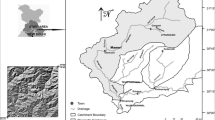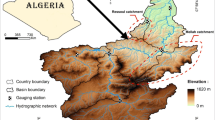Abstract
The present study explores for the first time the possibility of modelling sediment concentration with artificial neural networks (ANNs) at Gangotri, the source of Bhagirathi River in the Himalaya. Discharge, rainfall and temperature have been considered as the main controlling factors of variations in sediment concentration in the dynamic glacial environment of Gangotri. Fourteen feed forward neural networks with error back propagation algorithm have been created, trained and tested for prediction of sediment concentration. Seven models (T1-T7) have been trained and tested in the non-updating mode whereas remaining seven models (T1a-T7a) have been trained in the updating mode. The non-updating mode refers to the scenario where antecedent time (previous time step) values are not used as input to the model. In case of the updating mode, antecedent time values are used as network inputs. The inputs applied in the models are either the variables mentioned above as individual factors (single input networks) or a combination of them (multi-input networks). The suitability of employing antecedent time-step values as network inputs has hence been checked by comparative analysis of model performance in the two modes. The simple feed forward network has been improvised with a series parallel non-linear autoregressive with exogenous input (NARX) architecture wherein true values of sediment concentration have been fed as input during training. In the glacial scenario of Gangotri, maximum sediment movement takes place during the melt period (May–October). Hence, daily data of discharge, rainfall, temperature and sediment concentration for five consecutive melt periods (May–October, 2000–2004) have been used for modelling. High Coefficient of determination values [0.77–0.88] have been obtained between observed and ANN-predicted values of sediment concentration. The study has brought out relationships between variables that are not reflected in normal statistical analysis. A strong rainfall: sediment concentration and temperature: sediment concentration relationship is shown by the models which are not reflected in statistical correlation. It has also been observed that usage of antecedent time-step values as network inputs does not necessarily lead to improvement in model performance.








Similar content being viewed by others
References
ASCE Task Committee on Application of the Artificial Neural Networks in Hydrology (2000). Artificial neural networks in hydrology I: preliminary concepts. Journal of Hydraulic Engineering, ASCE, 5(2), 115–123.
ASCE Task Committee on Application of The Artificial Neural Networks in Hydrology (2000). Artificial neural networks in hydrology II: hydrologic applications. Journal of Hydraulic Engineering, ASCE, 5(2), 124–137.
Barnard, P. L., Owena, L. A., & Finkela, R. C. (2004). Style and timing of glacial and paraglacial sedimentation in a monsoon-influenced high Himalayan environment, the upper Bhagirathi Valley, Garhwal Himalaya. Sedimentary Geology, 165, 199–221.
Bishop, C. M. (1995). Neural networks for pattern recognition. Oxford.:Clarendon Press.
Boukhrissa, Z. A., Khanchoul, K., Le Bissonnais, Y., & Tourki, M. (2013). Prediction of sediment load by sediment rating curve and neural network (ANN) in El Kebir catchment. Algeria Journal of Earth System Sciences, 122(5), 1303–1312.
Carey, M., Baraer, M., Mark, B. G., French, A., Bury, J., Young, K. R., & McKenzie, J. M. (2014). Toward hydro-social modeling: merging human variables and the social sciences with climate-glacier runoff models (Santa River, Peru). Journal of Hydrology, 518(60–70).
Chakrapani, G. J. (2005a). Factors controlling variations in river sediment loads. Current Science, 88(4), 569–575.
Chang, F. J., & Chen, Y. C. (2001). A counter propagation fuzzy-neural network modeling approach to real time streamflow prediction. Journal of Hydrology, 245, 153–164.
Cigizoglu, H. K. (2008). Artificial neural networks in water resources. Integration of Information for Environmental Security, 115–148.
Cohen, S., Kettner, A.J., Syvitski, J.P.M (2013). WBMsed: a distributed global-scale riverine sediment flux model—model description and validation. Computer Geosciences
Dawson, C. W., & Wilby, R. L. (2001). Hydrological modelling using artificial neural networks. Progress in Physical Geography, 25(1), 80–108.
Dogan, E., Yuksel, I., & Kisi, O. (2007). Estimation of total sediment load concentration obtained by experimental study using artificial neural networks. Environmental Fluid Mechanics, 7, 271–288.
Gautam, M. R., Watanabe, K., & Saegusa, H. (2000). Runoff analysis in humid forest catchment with artificial neural network. Journal of Hydrology, 235, 117–136.
Garg, V. (2014). Modeling catchment sediment yield: A genetic programming approach. Natural Hazards, 70, 39–50.
Hall MJ, Minns AW (1993). Rainfall-runoff modeling as a problem in artificial intelligence: experience with neural network.” Proceedings of 4th British Hydrological Society Symposium, Cardiff, UK, 5.51–5.57.
Haritashya, U. K., Singh, P., Kumar, N., & Gupta, R. P. (2006). Suspended sediments from Gangotri Glacier: quantification, variability and correlations with discharge and temperature. Journal of Hydrology, 321, 116–130.
Haritashya, U.K. (2005). Glacio-hydrological studies of the Gangotri Glacier basin, Himalayas. Ph.D Thesis, Department of Earth Sciences, Indian Institute of Technology, Roorkee, India, p 360.
Haritashya, U. K., Singh, P., & Kumar, A. (2010). Particle size characteristics of suspended sediment transported in meltwater from the Gangotri Glacier, central Himalaya—an indicator of subglacial sediment evacuation. Geomorphology, 122(2010), 140–152.
Hasnain, S. I. (1996). Factors controlling sediment transport in Himalayan Glacier melt waters. Journal of Hydrology, 181, 49–62.
Hsu, K., Gupta, V. H., & Sorooshian, S. (1995). Artificial neural network modeling of the rainfall-runoff process. Water Resour. Research, 31(10), 2517–2530.
Kaur, R., Srinivasan, R., Mishra, K., Dutta, D., Prasad, D., & Bansal, G. (2003). Assessment of SWAT model for soil and water management in India. Land Use Water Resources Research, 3, 1–7.
Kettner, A. J., Restrepo, J. D., & Syvitski, J. P. M. (2010). A spatial simulation experiment to replicate fluvial sediment fluxes within the Magdalena River Colombia. Journal of Geology, 118, 363–379.
Kettner, A.J. & Syvitski, J.P.M (2009). Fluvial responses to perturbations in the Northern Mediterranean since the Last Glacial Maximum. Quatenary Science Review.
Kisi, O., & Aytek, A. (2013). Explicit neural network in suspended load estimation. Neural Network World., 23(6), 587–607.
Kumar, K., Miral, M. S., Joshi, S., Pant, N., Joshi, V., & Joshi, L. M. (2009). Solute dynamics of meltwater of Gangotri glacier, Garhwal Himalaya, India. Environmental Geology, 58, 1151–1159.
Maier HR, Dandy GC (2000). Neural networks for the prediction and forecasting of water resources variables: a review of modelling issues and application.” Environment Modelling and Software, 15, 101–124.
Minns, A. W., & Hall, M. J. (1996). Artificial neural networks as rainfall runoff models. Hydrologic Science Journal, 41(3), 399–417.
Mustafa, M. R., Rezaur, R. B., Saiedi, S., & Isa, M. H. (2012). River suspended sediment prediction using various multilayer perceptron neural network training algorithms: A case study in Malaysia. Water Resources Management, 26, 1879–1897.
Nagy, H. M., Watanabe, K., & Hirano, M. (2002). Prediction of sediment load concentration in rivers using artificial neural network model. Journal of Hydraulic Engineering, 128(6), 588–595.
Naithani, A. K., Nainwal, H. C., Sati, K. K., & Prasad, C. (2001). Geomorphological evidences of retreating of Gangotri glacier and its characteristics. Current Science, 80(1), 87–94.
Pelletier, J.D (2012). A spatially distributed model for the long-term suspended sediment discharge and delivery ratio of drainage basins. Journal of Geophysical
Rai, R. K. & Mathur, B. S. (2007). Event-based sediment yield modeling using artificial neural network. Water Resources Management, 22, 423–441.
Rajaee, T., Mirbagheri, S. A., Nourani, V., & Alikhani, A. (2009). Prediction of daily suspended sediment load using wavelet and neurofuzzy combined model. Journal of Environmental Science and Technology, 7(1), 93–110.
Rajurkara, M. P., Kothyari, U. C., & Chaube, U. C. (2004). Modeling of the daily rainfall-runoff relationship with artificial neural network. Journal of Hydrology, 285, 96–113.
Reddy SB (2003). Estimation of watershed runoff using artificial neural networks. Ph.D Thesis in Agricultural Engineering (unpublished) Post Graduate School, IARI, New Delhi.
Rumelhart, D. E., McLelland, J. L., & PDP Research Group (1986). Parallel distributed processing, explorations in the micro structure of cognition, Vol. I: Foundations. Cambridge, Massachusetts:MIT Press.
Sajikumar, N., & Thandaveswara, B. S. (1999). A nonlinear rainfall runoff model using an artificial neural network. Journal of Hydrology, 216, 32–55.
Sarangi, A., & Bhattacharya, A. K. (2000). Use of geomorphological parameters for sediment yield prediction from watersheds. Journal of Soil Water Conservation, 44(1–2), 99–106.
Sarangi, A., & Bhattacharya, A. K. (2005). Comparison of artificial neural network and regression models for sediment loss prediction from Banha watershed in India. Agricultural Water Management, 78, 195–208.
Shamseldin, A. Y. (1997). Application of a neural network technique to rainfall runoff modeling. Journal of Hydrology, 199, 272–294.
Singh, P., Haritashya, U. K., Ramasastri, K. S., & Kumar, N. (2005). Diurnal variations in discharge and suspended sediment concentration, including runoff-delaying characteristics, of the Gangotri Glacier in the Garhwal Himalayas. Hydrological Processes, 19, 1445–1457.
Singh, P., Haritashya, U. K., Kumar, N., & Singh, Y. (2006). Hydrological characteristics of the Gangotri Glacier, central Himalayas, India. Journal of Hydrology, 327, 55–67.
Singh, P., Kumar, A., & Kishore, N. (2011). Meltwater storage and delaying characteristics of Gangotri glacier (Indian Himalayas) during ablation season. Hydrological Processes, 25, 159–166.
Singh, V. B., Ramanathan, A. L., Pottakkal, J. G., & Kumar, M. (2014). Seasonal variation of the solute and suspended sediment load in Gangotri glacier meltwater, central Himalaya. India, Journal of Asian Earth Sciences, 79, 224–234.
Smith, J., & Eli, R. N. (1995). Neural network models of rainfall runoff process. Journal of Water Resources Planning and Management, ASCE, 121(6), 499–508.
Sudheer KP (2005). Knowledge extraction from trained neural network river flow models. ASCE, (1084–0699).
Syvitski, J. P. M., Kettner, A. J., Peckham, S. D., & Kao, S. J. (2005). Predicting the flux of sediment to the coastal zone: application to the Lanyang watershed, Northern Taiwan. Journal of Coastal Research, 21, 580–587.
Syvitski, J. P. M., & Milliman, J. D. (2007). Geology, geography, and humans battle for dominance over the delivery of fluvial sediment to the coastal ocean. Journal of Geology, 115(1), 1–19.
Tettamanzi, A., & Tomassini, M. (2001). Soft Computing. Berlin Heidelberg: Springer Verlag.
Tokar, A. S., & Johnson, P. A. (1999). Rainfall runoff modeling using artificial neural networks. Journal of Hydraulic Engineering, ASCE, 4(3), 232–239.
Yitian, L., & Gu, R. R. (2003). Modeling flow and sediment transport in a river system using an artificial neural network. Environmental Management., 31(1), 122–134.
Zhang, B., & Govindaraju, R. (2003). Geomorphology-based artificial neural networks (GANNs) for estimation of direct runoff over watersheds. Journal of Hydrology, 273, 18–34.
Author information
Authors and Affiliations
Corresponding author
Rights and permissions
About this article
Cite this article
Singh, N., Chakrapani, G.J. ANN modelling of sediment concentration in the dynamic glacial environment of Gangotri in Himalaya. Environ Monit Assess 187, 494 (2015). https://doi.org/10.1007/s10661-015-4672-6
Received:
Accepted:
Published:
DOI: https://doi.org/10.1007/s10661-015-4672-6




